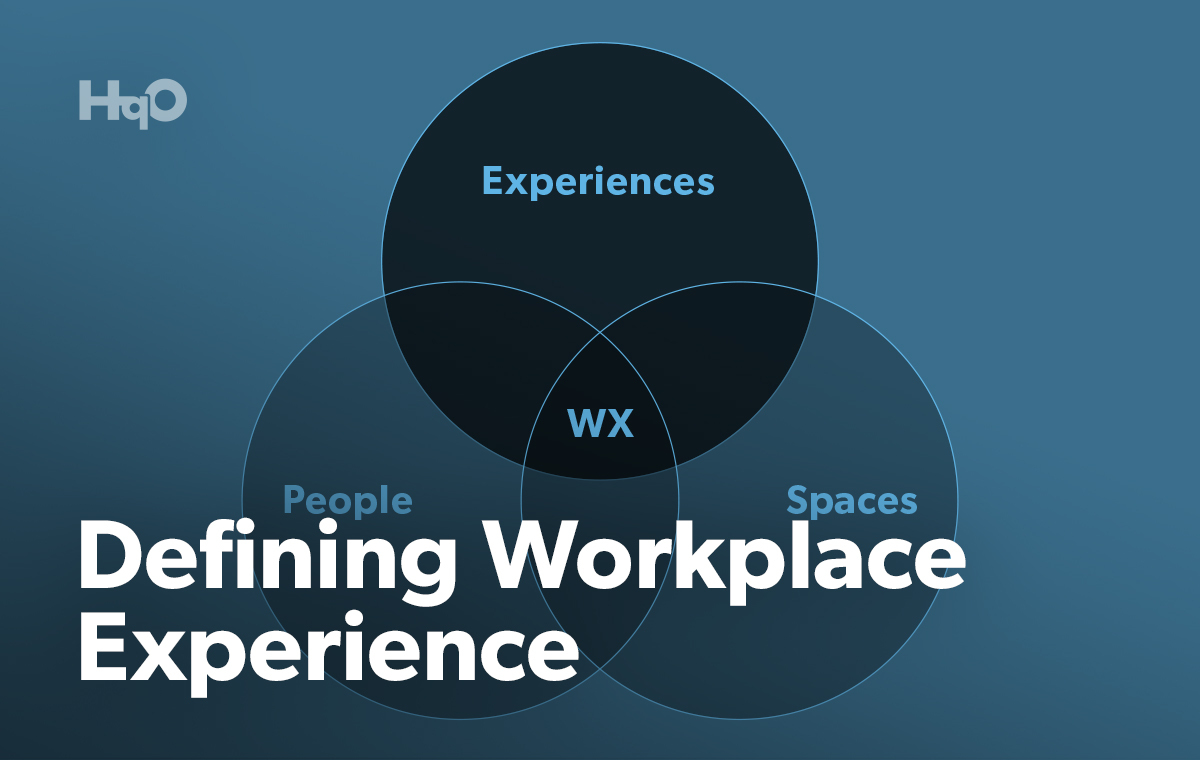So, what is workplace experience?
It’s a term that has become increasingly common, but it can take on many different meanings depending on the company. In order to understand the benefits of improving the workplace experience, it’s important to first have a clear understanding of both the term and its importance for employers.
Simply put, workplace experience consists of the experiences, people, and spaces that employees interact with in the workplace — whether in the physical office or remote. These components can be fueled and amplified by technology, empowering people to do their best work regardless of location. Below are just a few examples of this dynamic.
Experiences:
- Building access control
- Menus and order ahead
- Room booking
- Parking & transit
People:
- Office socializing
- Vendor/services interactions
- Coworker interactions
- Workplace culture and climate
Spaces:
- In-office
- Work from home
- Office common areas
- Satellite offices
- Coworking spaces
- Office amenity spaces
Once a company connects employees to each other, their overall workplace culture, and the physical spaces and resources offered to them, they will be able to generate both short- and long-term success.
Why You Should Care About Workplace Experience
Employers value workplace experience because the quality of that experience directly affects the bottom line. Research shows, for example, that investments in workplace experience lead to increased employee productivity (a 29% increase in work quality, according to Gallup) and decreased levels of absenteeism, among other benefits.
And, when it comes to workplace experience technology, the financial benefits are overwhelmingly clear: companies like EY find that the implementation of workplace experience technology yields direct financial benefits for commercial real estate companies. This sentiment is further backed by HqO’s State of Workplace Experience in 2022 report, which states that 72% of employers agree that workplace experience and engagement tools will be a critical element of successful offices in the future.
Employers also need to be mindful of the workplace experience because that experience is hugely important to their employees. HqO’s aforementioned report, for example, finds that 92% of office landlords believe employees want more from their offices. Additionally, in a Q2 Global Office Working survey by Leesman (an HqO company), only 61% of surveyed employees out of almost a million respondents believe that their office environments allow them to work productively. These and other data points clearly show that employees are now demanding more from the workplace experience.
The Benefits of Workplace Experience Technology
Workplace experience technology enables employees to manage their workplace experience; think of it as a remote control for the workplace, similar to a TV remote control. When executed well, it can bring together the different capabilities that employees need all under a single pane of glass (i.e. all in a single, easy-to-use app).
Workplace experience technology should also support the needs of Workplace Experience Managers, Real Estate, Facilities, and HR Managers with targeted real-time outreach, ongoing communications, and behavioral and feedback analytics for better decision-making.
And, to further generate business benefits, a growing number of Workplace Experience Managers are using technology to help their companies optimize spending and attract and retain top talent. Recent research indicates that investment in strong workplace technology yields tangible, obvious results.
On a practical level, workplace experience technology helps employers create deeper workplace connections, optimize the office, and ensure employee safety. Find a more detailed breakdown below:
Do More With Fewer Applications
A report from Asana finds that the average U.S. employee changes through 13 apps, 30 times per day. By providing a unified, digital solution like HqO’s Workplace Experience Platform, you can make your employees’ lives easier and more productive by consolidating multiple features and benefits into one app. It gives them a universal remote control to your offices, and empowers workers to quickly schedule the spaces they need to do their work. In addition, when employers use a single unified app, they can increase app usage by focusing promotion and programming on that one app instead of multiple apps. Moreover, each time an employee uses the app, they can discover other functions that can help them as well. Consolidation drives better outcomes.
Create Deeper Connections
In the age of hybrid work, it can be hard for employers to foster a workplace culture and sense of community that many companies used to take for granted. Workplace experience technology helps employers create deeper, more meaningful connections to and among their workforce by providing opportunities for expanded in-office and remote programming, discounts at local retailers, as well as a list of other enhanced perks.
Additionally, because employees can download the app on their smartphones, employer messaging is guaranteed to be consistent for all workers — whether they’re in or out of the office. Furthermore, real-time mobile messaging increases the likelihood that employees will actually see those messages.
Optimize the Office
This information enables companies and workplace experience managers to tailor the workplace to the needs of employees by investing in the most popular programs and amenities, while simultaneously reducing investment in less popular amenities and spaces. This optimization allows companies to boost employee satisfaction, while also getting the most out of their spending on the workplace.
Enhance Employee Safety
As COVID-19 enters its endemic stage, employers need to be able to effectively communicate safety concerns to their employees. For example, HqO’s custom communication feature allows employers to send messages directly to employees’ phones — enabling companies to remain in contact about safety issues as they arise. Not only does this give employers the ability to keep their employees safe during an uncertain time, it also allows them to boost employee satisfaction by communicating proactively, with a uniform cadence. The HqO app also allows employers to manage occupancy limits, empowering them to keep their workers safe in uncertain times.
Interested in learning more? Download HqO’s An Introduction to Workplace Experience guide.



